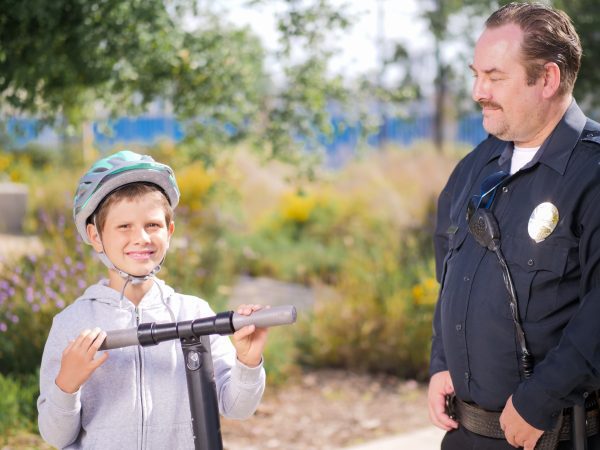In an era where eco-friendly and efficient transportation options are gaining popularity, scooters have emerged as a trendy and practical choice for short-distance commuting and leisurely rides. Embracing the spirit of adventure while zipping through city streets or scenic trails, scooter enthusiasts are relishing the newfound freedom these two-wheeled wonders provide. However, with the increasing popularity of scooters, a growing concern for safety and responsible riding practices has arisen.

In this article, we delve into the myriad benefits of safety exercise for scooters, exploring how it transforms scooter enthusiasts into proficient and safety-conscious riders. From mastering fundamental riding techniques to understanding the importance of safety gear, this training amalgamates education with entertainment, creating an engaging experience that leaves a lasting impact.
Join us as we venture into the world of safety training for scooters, uncovering the reasons why it has become a pivotal step for riders of all ages and experiences. Discover how this initiative is paving the way for a safer and more enjoyable riding culture, inspiring a new generation of riders to navigate the streets with confidence and responsibility. Whether you’re a seasoned rider or a beginner, the fusion of fun and safety in exercise for scooters promises to enrich your scooter riding adventures like never before. Let’s rev up our enthusiasm and explore the incredible journey of mastering the ride!
Share your thoughts and experiences with us by leaving a comment, and let us know what you think about safety exercise for scooters!
Key Takeaways
- Safety exercise for scooters combines fun and learning, making the process engaging and effective.
- Participants gain essential riding skills, such as balance, coordination, and maneuvering, leading to improved scooter control.
- Understanding traffic rules ensures riders know their rights and responsibilities on the road.
- Accident prevention is a major focus, with exercise covering hazard recognition, defensive riding, and emergency handling.
- Safety exercise emphasizes the use of proper safety gear, reducing the severity of injuries in case of accidents.
- Riders become more aware of potential risks and dangers, promoting proactive risk management.
- Responsible riding is encouraged, fostering a safer road environment and better interactions with other road users.
- Parents gain peace of mind knowing their children are equipped with the necessary skills for safe scooter riding.
- Community awareness about scooter safety fosters a positive safety culture and may lead to infrastructure improvements.
- Safety exercise for scooters encourages responsible behavior and creates a supportive network among riders.
Understanding The Importance Of Protection Exercises
Safety training for scooters is of utmost significance in today’s world due to the increasing popularity of scooters as a means of transportation and recreation. This training aims to equip riders with essential skills and knowledge to ensure their safety and that of others on the roads. It fosters a strong awareness of potential hazards and defensive riding techniques, empowering riders to anticipate and avoid risks effectively. Moreover, the training focuses on honing fundamental riding skills like balance, braking, and maneuvering, leading to better control over scooters and smoother rides.
Participants also gain a comprehensive understanding of traffic laws and regulations, fostering compliance and harmony on the roads. The emphasis on wearing safety gear promotes a safety-first mindset, minimizing the risk of injuries. Additionally, safety training provides valuable insights into emergency procedures and first aid, ensuring riders can respond promptly and appropriately in case of accidents. By building a supportive community of scooter enthusiasts, safety exercise encourages responsible riding practices and contributes to a safer and more considerate scooter culture overall.
The Benefits Of Safety Exercises
Safety training for scooters offers numerous benefits, as it effectively combines fun and learning to promote safe riding practices. Whether it’s for children or adults, engaging in proper safety training can lead to the following advantages:
Accident Prevention
Safety training for scooters offers a vital advantage: accident prevention. Teaching fundamental riding skills, traffic awareness, hazard recognition, and defensive riding strategies equips riders to make informed decisions and avoid collisions. Additionally, the exercise covers emergency handling, safe maneuvering, and the importance of wearing safety gear. With this knowledge, riders can minimize risks and enjoy a safer and more responsible scooter experience.
Improved Riding Skills
Safety exercise for scooters provides also the advantage of improved riding skills. Participants learn essential techniques for balance, coordination, and maneuvering, enhancing their ability to ride confidently and safely. These newfound skills translate into better control over their scooters, reducing the likelihood of accidents and promoting an overall enjoyable riding experience. Similar to exercises for motorcycles, the training helps to make you a better rider.
Understanding Traffic Rules
Understanding traffic rules is a significant advantage of safety training for scooters. Participants learn the specific regulations and laws that apply to scooters, ensuring they are aware of their rights and responsibilities on the road. This knowledge enables riders to navigate through traffic safely, make informed decisions, and interact with other road users more effectively. By promoting adherence to traffic rules, safety exercise contributes to a safer riding environment and fosters a sense of responsibility and respect among scooter riders. These motorcycle endorsement rules are similar to those required for obtaining a license for driving a motorcycle, which also typically involves passing a written test.

Confidence Building
Confidence building is a notable advantage of safety training for scooters. Through comprehensive instruction and practical experience, participants gain the necessary skills and knowledge to ride their scooters safely. This newfound competence instills a sense of self-assurance in riders, making them feel more comfortable and secure while riding. As riders become more confident in their abilities to handle various situations on the road, they are more likely to enjoy their scooter experiences and explore new riding opportunities. Ultimately, confidence building fosters responsible and skilled riders, leading to a safer and more enjoyable scooter-riding community.

Injury Minimization
Injury minimization is a crucial advantage of safety training for scooters. By emphasizing the importance of wearing proper safety gear, such as helmets, knee pads, and elbow pads, participants learn how to protect themselves in case of accidents. Additionally, safety training teaches essential riding techniques, hazard recognition, and defensive riding strategies that reduce the risk of collisions and falls. As a result, riders are better equipped to prevent or mitigate injuries, promoting a safer and more responsible scooter riding experience for everyone involved.
Risk Awareness
Risk awareness is a significant advantage of safety exercises for scooters. Participants learn to recognize potential hazards and dangers while riding, enabling them to proactively assess and manage risks on the road. This heightened awareness helps riders make informed decisions and take appropriate precautions, reducing the likelihood of accidents. By promoting risk-awareness, safety training empowers scooter riders to anticipate and respond to challenging situations, ultimately leading to a safer and more secure riding experience for themselves and others around them.
Responsible Riding
Responsible riding is a prominent advantage of safety training for scooters. Participants learn not only the necessary riding skills but also the importance of following traffic rules, respecting other road users, and being considerate of pedestrians. Safety training instills a sense of responsibility in riders to make safe choices and prioritize the well-being of themselves and others. By promoting responsible riding practices, safety training contributes to a safer and more harmonious road environment, reducing the likelihood of accidents and fostering a positive image of scooter riders within the community.
Fun Learning Experience
A significant advantage of safety training for scooters is that it provides a fun learning experience for participants. Through interactive and engaging methods, such as games, simulations, and practical exercises, safety training makes the learning process enjoyable and exciting. Participants are more likely to actively engage and retain information when they are having fun, which enhances the effectiveness of the training.
By combining fun and learning, safety exercises for scooters can create a positive and motivating atmosphere, encouraging participants to be enthusiastic about acquiring essential safety skills. This positive approach not only increases knowledge retention but also fosters a more positive attitude toward safety measures and responsible riding practices. As a result, participants are more likely to embrace and apply the knowledge gained during the training, leading to safer and more responsible scooter riders overall.
Parental Peace Of Mind
Safety exercise for scooters provides a significant advantage for parents by offering them peace of mind. When their children undergo proper safety exercises, parents can feel reassured that their young riders are equipped with essential skills and knowledge to ride scooters safely. Knowing that their children have learned how to handle potential hazards, follow traffic rules, and wear appropriate safety gear, parents can trust that their kids are better prepared to navigate the road responsibly.
Safety exercise also helps instill a sense of responsibility and caution in young riders, making them more aware of the potential risks and dangers associated with scooter riding. This heightened awareness, combined with the practical skills gained during training, reduces the likelihood of accidents and injuries.
Ultimately, safety exercise for scooters empowers young riders to be more confident and responsible while using their scooters, which provides parents with the peace of mind that their children can enjoy their scooters safely and responsibly, minimizing the potential for accidents or mishaps.
Community Awareness
Community awareness is another advantage of safety training for scooters. When safety exercise programs are conducted and promoted within the community, they raise awareness about the importance of safe scooter riding practices among both riders and non-riders.
- Promoting Secured Culture: By advocating for safety exercise, the community acknowledges the significance of responsible riding, which can foster a culture of safety among scooter users.
- Educating Non-Riders: Safety training initiatives can educate non-riders, such as pedestrians and motorists, about the specific challenges and risks faced by scooter riders. This leads to better understanding and consideration between different road users.
- Safe Environment: As more people participate in safety exercises, the overall safety of the community improves. Riders who have undergone training are more likely to follow traffic rules and exhibit responsible behavior on the road, reducing the potential for accidents.
- Advocacy for Infrastructure Improvements: Community awareness about scooter safety can lead to increased advocacy for better infrastructure, such as dedicated scooter lanes and improved road conditions, making the community more scooter-friendly.
- Setting a Positive Example: When individuals see others participating in safety exercises and practicing responsible riding, it sets a positive example for the entire community, encouraging more people to prioritize safety.
- Involving Local Authorities: Community awareness about scooter safety can prompt local authorities to prioritize scooter-related safety initiatives, such as awareness campaigns, safety education in schools, or allocating resources for infrastructure improvements.
- Preventing Stigmatization: Safety training can help dispel negative stereotypes or stigmatization associated with scooter riders. When riders demonstrate responsible behavior, it challenges any negative perceptions and promotes a more positive image of scooter users in the community.
- Building Support Networks: Safety exercise initiatives can bring scooter riders together, fostering a sense of community and support. This network can further promote safe riding practices and provide assistance or advice to newer riders.
In summary, community awareness about scooter safety through training programs and initiatives benefits both riders and the broader community. It encourages responsible riding behavior, improves road safety, and fosters a positive and inclusive environment for all road users.

Conclusion
Safety training for scooters offers a host of valuable advantages that benefit individuals and communities alike. The training effectively combines fun and learning, equipping riders with essential skills and knowledge to promote safe and responsible scooter riding practices.
The primary advantages include accident prevention, as participants learn how to handle their scooters skillfully and avoid potential hazards. Understanding traffic rules ensures that riders are aware of their rights and responsibilities, leading to more informed and considerate behavior on the road. Additionally, safety exercise fosters confidence in riders, empowering them to enjoy their scooters while feeling secure and competent.
Moreover, injury minimization is a significant outcome of safety exercise, as riders are educated on the importance of using appropriate safety gear and applying defensive riding strategies. Risk awareness further contributes to accident prevention, enabling riders to proactively identify and manage potential dangers on the road.
Importantly, safety training for scooters instills a sense of responsibility, not only in riders but also in the broader community. Parents gain peace of mind knowing their children are well-prepared to ride safely, and community awareness about scooter safety promotes a positive safety culture and encourages responsible behavior among all road users.
By providing a fun learning experience, safety training encourages active participation and knowledge retention, leading to more responsible and safety-conscious scooter riders. Overall, safety exercise for scooters is an essential investment, fostering a safer and more enjoyable riding experience while promoting a sense of responsibility and respect within the community.
Frequently Asked Questions (FAQs)
What Are The Safety Issues With E Scooters?
Safety issues with e-scooters include lack of rider training, increased vulnerability in traffic, and the potential for collisions with pedestrians or other vehicles.
How Can You Be Safe On A Scooter?
To be safe on a scooter, always wear a helmet and other protective gear, obey traffic laws, stay alert and aware of your surroundings, and avoid riding at high speeds or in hazardous conditions.
How Do You Drive A Scooter For Beginners?
For beginners, it is important to take an online course or receive proper training from a school to learn the basics of scooter operation, including starting, stopping, turning, and maintaining balance. This is similar to the basic ridercourse offered by the Motorcycle Safety Foundation for motorcycle riders.
What Age And Safety Is Scooter?
The appropriate age for riding a scooter varies depending on local regulations and the type of scooter. However, regardless of age, it is crucial to prioritize safety by wearing appropriate protective gear and following traffic laws. Parents should also ensure that young riders have undergone a safety program before riding.
What Is The Most Safety Scooter?
The safety of a scooter depends on various factors, such as its design, features, and rider behavior. It is recommended to research and choose a scooter that meets safety standards, has reliable braking systems, and has good stability. Make sure to gather all necessary information before making a purchase.
What Are The Most Common Scooter Accidents?
The most common scooter accidents involve collisions with other vehicles, pedestrians, or fixed objects, as well as single-vehicle accidents caused by loss of control, uneven surfaces, or excessive speed.
How Can You Prevent A Scooter Accident?
To prevent a scooter accident, ensure regular maintenance of your scooter on your free time or weekend, follow traffic rules and regulations, stay visible to other road users, avoid distractions while riding, and maintain a safe speed appropriate for the conditions.
How Can I Be The Most Safe On My Motorcycle?
To be the most safe on a motorcycle, it is important to undergo proper motorcycle safety exercise, such as the basic rider course offered by the Motorcycle Safety Foundation with its experienced riders. Wearing protective gear, including a helmet, long-sleeved shirt (preferably leather), and sturdy footwear, is essential. Adhering to traffic rules, maintaining a safe speed, and being aware of one’s surroundings can further enhance motorcycle safety. Obtaining a proper motorcycle license after passing the written test at the DMV is also crucial for safety.
What Is A Safe Speed On A Scooter?
The safe speed on a scooter depends on various factors such as road conditions, traffic flow, and the rider’s experience. It is important to ride at a speed that allows for proper control and reaction to unexpected situations.
Why Do Scooter Accidents Happen?
Scooter accidents can happen due to factors such as rider inexperience, reckless behavior, lack of proper exercise, poor road conditions, distracted driving, or the negligence of other road users. It is crucial to identify and address these factors to prevent accidents.
